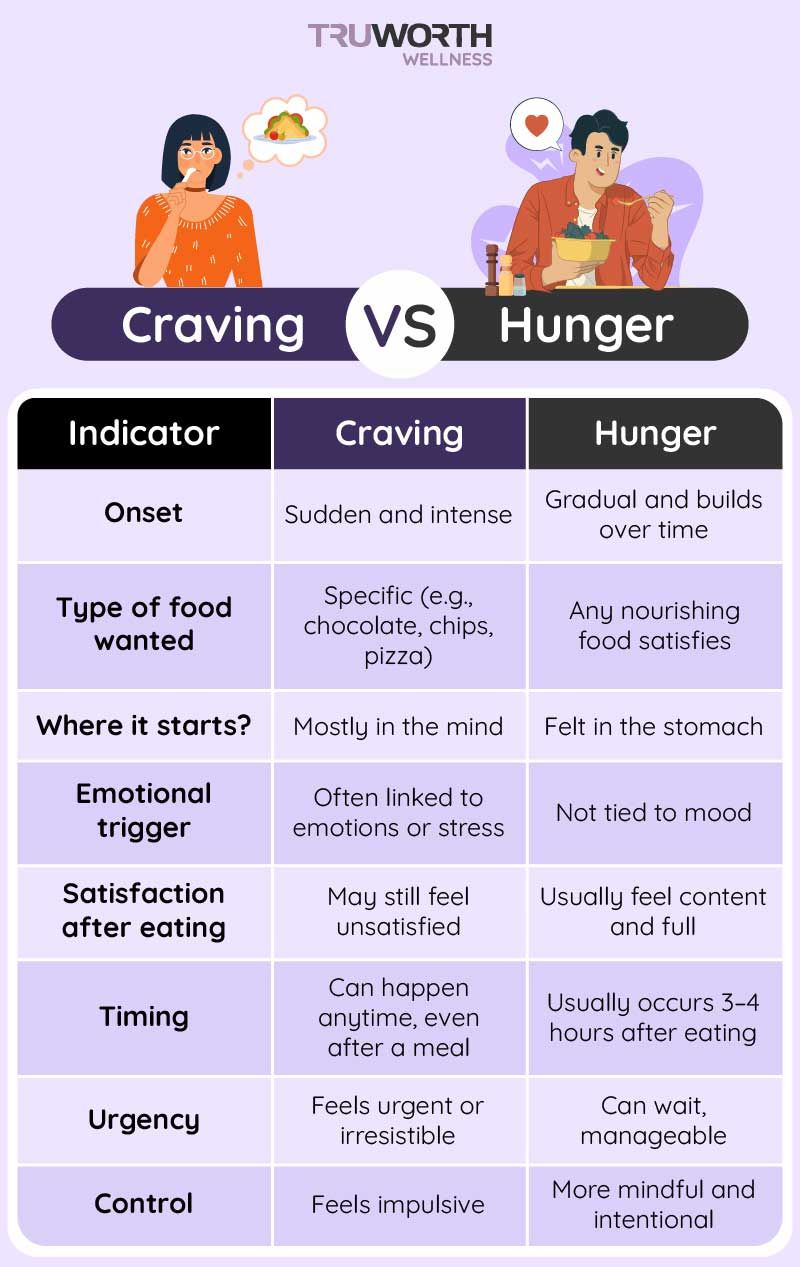Cravings That Are Often Mistaken For Hunger – And What To Do?

We’ve all been there. You just ate lunch an hour ago, and yet you're reaching for a packet of chips or a cookie from your drawer. Are you hungry—or is something else nudging you to eat?
It’s easy to confuse a craving with real hunger, especially in today’s busy work culture, where stress, boredom, and emotional overload are all too common. But understanding the difference can be a game-changer—not just for your health, but for your energy, focus, and relationship with food.
Let’s unpack what cravings are, how they’re different from hunger, and how to respond in a way that supports your overall well-being.
Must Read: Conquering Overeating At Work

What’s the Difference Between Hunger and Craving?
Hunger is your body’s natural signal that it needs fuel. It develops gradually, can be satisfied with almost any food, and goes away after eating.
Craving, on the other hand, is often sudden, specific, and emotionally charged. You might crave a particular texture (crunchy chips) or taste (something sweet or salty), and even after eating, you may still feel unsatisfied.
Cravings tend to target the brain more than the body, and that’s where things get interesting.
Common Cravings Mistaken for Hunger
Here are a few everyday scenarios where a craving feels like hunger, but isn't.
1. Craving Due to Stress
Ever noticed how deadlines, arguments, or pressure-packed moments make you crave sugar or fried snacks?
Why does it happen? Stress triggers the release of cortisol, a hormone that increases appetite, especially for high-energy foods. Your body is trying to self-soothe with comfort food.
What to do?
- Pause and breathe: Even a minute of deep breathing can lower cortisol levels.
- Sip water or herbal tea instead of snacking immediately.
- Try a quick stretch or walk to reset your mood before you reach for food.
2. Craving Out of Boredom
You’re not hungry, but you keep checking the fridge. Or opening that snack drawer for the third time today. Sound familiar?
Why does it happen? When you're bored, your brain craves stimulation. Food is the easiest form of that.
What to do?
Change your activity: Listen to music, call a friend, or do a puzzle.
Keep healthy “boredom snacks” like cucumber slices or roasted makhana ready if you must nibble.
Ask yourself: Would I eat an apple right now? If not, it’s probably a craving.
3. Craving from Dehydration
Mild dehydration often masquerades as hunger. That dull fatigue or slight emptiness in the stomach can fool you into thinking you need food.
What to do?
- Drink a glass of water first.
- Wait 10–15 minutes to see if the “hunger” fades.
- Keep a water bottle on your desk to stay hydrated throughout the day.
4. Craving from Habit or Timing
Do you feel like eating at 4 PM just because it's “snack time,” not because you're hungry?
Why does it happen? Your body gets conditioned to expect food at certain times, even if it doesn’t need it.
What to do?
- Try delaying your snack by 15–20 minutes to assess if hunger is real.
- Swap out routine snacks with mindful alternatives like fruits or nuts.
- Break the pattern gently—skip or shift snack times without guilt.
Must Read: Calm Your Sugar Craving With These 5 Healthy Foods
5. Craving from Emotional Eating
You’ve had a rough day. And suddenly, only a bar of chocolate feels like the answer.
Why does it happen? Emotional eating is a coping mechanism—food becomes a reward, distraction, or escape.
What to do?
Name the emotion: Are you sad, frustrated, lonely? Identifying it reduces its power.
Try journaling, talking to someone, or even venting on a notes app.
Keep “pause foods” like peppermint tea or a small protein bar handy—just enough to slow down and reflect.
6. Craving From Poor Sleep
Sleep-deprived nights often lead to strong cravings the next day, especially for sugary or high-carb foods.
Why does it happen? Lack of sleep disrupts ghrelin and leptin, hormones that regulate hunger and satiety.
What to do?
Prioritize rest where you can—even a short midday nap can help.
Opt for energy-stabilizing foods like yogurt, fruits, or eggs instead of sugary snacks.
Stick to regular meals to avoid erratic blood sugar swings.
One More Thing: You’re Not Alone
If you’ve ever confused a craving with hunger, welcome to being human. Most of us aren’t taught how to listen to our bodies, especially when work, stress, and screens constantly pull us away from ourselves.
This isn’t about guilt or “fixing” yourself. It’s about learning a new kind of awareness—gradually, and with kindness. The goal isn’t to never eat a cookie again. The goal is to know why you’re reaching for it—and to feel okay with the choice you make.
It takes practice. And you don’t have to do it perfectly.
Even noticing the difference between craving and hunger just once today? That’s progress.
Also Check: Tips For Healthy Snacking At Work
So, What Can You Do Overall?
Cravings aren’t “bad.” They’re signals—just not always about food. The key is to pause, identify the root cause, and respond mindfully.
Here are some quick questions to ask yourself the next time you reach for something to eat:
- When was the last time I ate something nourishing?
- Am I hungry—or just feeling something else?
- Would I eat a bowl of dal and rice right now?
- Can I do something else first, and see how I feel in 10 minutes?
Over time, you’ll build a more intuitive relationship with food—one where your body leads, not your emotions.
Let Hunger Guide You—Not Habit
Mindful eating doesn’t mean ignoring cravings. It means understanding them and responding with care.
If you're curious about whether your current eating habits are driven by genuine hunger, stress, or automatic habits, take a few minutes to explore your eating patterns.